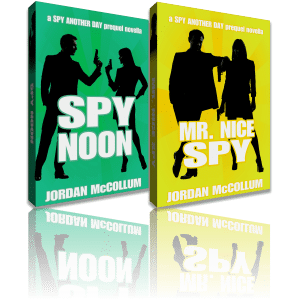Happy New Year!
It’s a time for making resolutions (for those things that sound good but we won’t really do) or setting goals (for those things that we actually want to do).
So here’s my favorite advice on setting goals. (It’s from me, but I had to get it somewhere at some point, right?) A goal you really want to achieve should be:
Written down
It’s even better to put them in a place where you can find them, see them often, and hopefully be reminded of them often. (Maybe next to those pieces of praise you’re going to tape to your wall 
Specific
 “Get better at writing” is too vague—if you finally learn the less/fewer rule tomorrow, are you done? We all always want to improve our skills, but a better goal would be to pick a specific skill to work on—to study techniques to create more vivid characters, for example. (It’s still a little vague, of course, but this may be the nature of the beast in this area.)
“Get better at writing” is too vague—if you finally learn the less/fewer rule tomorrow, are you done? We all always want to improve our skills, but a better goal would be to pick a specific skill to work on—to study techniques to create more vivid characters, for example. (It’s still a little vague, of course, but this may be the nature of the beast in this area.)
Use numbers or dates where they make sense: the number of words you write or edit, the amount of time you spend writing, the number of queries and submissions you send out.
Measurable
Whether the measurement is quantitative (like time spent) or qualitative (like more vivid characters), make sure it’s something you can see a difference in. This will probably involve reading something you wrote last year and objectively comparing your writing now. (If you can enlist a willing helper, outside opinion can be helpful—unless they give bad advice.)
Also useful here is to set a deadline for your goals: I want to study these skills by March 1, finish a first draft of my next WIP in 30 days, etc.
Personal
Just because someone else is setting a goal to write two hours a day doesn’t mean you have to. Keep in mind where you are in your writing and your life, and set goals that are suited to you.
Achievable
Aim high—but don’t literally aim for the stars (unless you a.) are an astronaut slated for flight or b.) like falling short). Choose something that you can achieve, but something you’ll have to work for.
Also in this area, it’s important to recognize when your goal isn’t completely (or at all) within your control: unless you also run a publishing company, it’s not your choice whether something gets published. So if you set more than one goal, be sure to include at least one goal that you have control over. On the other hand, don’t set more goals than you can handle or remember.
Broken down
 I don’t mean literally broken—I mean that your goals, especially your big goals, should be broken down into specific steps. “Write better” is already kind of broken down if you go with more specific things like creating more vivid characters. But even that can be broken down: read such-and-such a book (by Feb 15), take notes; discuss these techniques with/at X; brainstorm application; spend two weeks going through manuscript to apply notes, etc.
I don’t mean literally broken—I mean that your goals, especially your big goals, should be broken down into specific steps. “Write better” is already kind of broken down if you go with more specific things like creating more vivid characters. But even that can be broken down: read such-and-such a book (by Feb 15), take notes; discuss these techniques with/at X; brainstorm application; spend two weeks going through manuscript to apply notes, etc.
So, what are your writing goals for 2009? Feel free to share them in the comments—or, if you’ve blogged them, put the link into the URL box.
Photo credits: Nobel Prize—Tim Ereneta; writing list—Hannah Swithinbank
 I think we’ve all been there: we get some piece of advice—from a crit partner, from an editor, from a total stranger—that just doesn’t work for our story.
I think we’ve all been there: we get some piece of advice—from a crit partner, from an editor, from a total stranger—that just doesn’t work for our story.  And I just happen to have an orphan almost-kissing scene sitting around. It’s from an idea I’ve had bouncing around for a while and I finally figured out it should be a YA paranormal a few months ago. I’ve slowly been working on plotting it, but other than this half of a scene and some attempts at the opening paragraphs, there’s not much to the story.
And I just happen to have an orphan almost-kissing scene sitting around. It’s from an idea I’ve had bouncing around for a while and I finally figured out it should be a YA paranormal a few months ago. I’ve slowly been working on plotting it, but other than this half of a scene and some attempts at the opening paragraphs, there’s not much to the story. “Lacey,” the blame in his tone matching mine. “All you have to do is act like you’re gonna enjoy it.”
“Lacey,” the blame in his tone matching mine. “All you have to do is act like you’re gonna enjoy it.” And, like I’ve said above, I’ve intended to participate, but . . . for three years now, I never have, and this year will probably be the fourth.
And, like I’ve said above, I’ve intended to participate, but . . . for three years now, I never have, and this year will probably be the fourth.
 But man, when that idea strikes, it’s hard to make myself do the normal day-to-day, keeping-the-house-clean, being-a-mom stuff. All I want to do is write, and yet no matter how fast I write (my record is 5000 words in a day), it’s not fast enough. The rest of the book stretches out in front of me, scenes and lines and snippets that threaten to slip away before I can get there. So I race on.
But man, when that idea strikes, it’s hard to make myself do the normal day-to-day, keeping-the-house-clean, being-a-mom stuff. All I want to do is write, and yet no matter how fast I write (my record is 5000 words in a day), it’s not fast enough. The rest of the book stretches out in front of me, scenes and lines and snippets that threaten to slip away before I can get there. So I race on. For me, that’s stuff I can add later, in each layer of editing. In fact, I’m taking this week off drafting to go back to the first MS I wrote during this year to add in more of those descriptions and sensory information, since the second half of the book is rather bereft of those (silly me, thinking all the character and setting descriptions were established in the first half, and we wouldn’t need anymore after that!).
For me, that’s stuff I can add later, in each layer of editing. In fact, I’m taking this week off drafting to go back to the first MS I wrote during this year to add in more of those descriptions and sensory information, since the second half of the book is rather bereft of those (silly me, thinking all the character and setting descriptions were established in the first half, and we wouldn’t need anymore after that!).
 .
.
 So what, you ask? Well, those statistics mean that the average girl named Peyton is less than five years old right now. When I read these, I couldn’t help but thinking of the curly-haired toddler down the street. Although a strong, androgynous girls’ name is awesome and Peyton hits all the right notes with parents and authors alike today, that’s exactly what makes it all wrong when naming a character who’s supposed to be an adult today.
So what, you ask? Well, those statistics mean that the average girl named Peyton is less than five years old right now. When I read these, I couldn’t help but thinking of the curly-haired toddler down the street. Although a strong, androgynous girls’ name is awesome and Peyton hits all the right notes with parents and authors alike today, that’s exactly what makes it all wrong when naming a character who’s supposed to be an adult today.
 As I finish up what I hope will be the final major edits of my latest project, I’m getting ready to start my next project. But while I have several ideas to write next, I haven’t chosen one for sure.
As I finish up what I hope will be the final major edits of my latest project, I’m getting ready to start my next project. But while I have several ideas to write next, I haven’t chosen one for sure. 